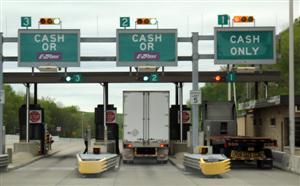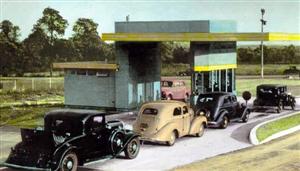JUNE 2008 TRUCKER TALK
A GOOD THING GONE BAD
BY WRITER & OWNER OPERATOR KIM GRIMM
You might be surprised to learn that America’s first toll road began as a proposed railroad. The “Grandfather of the Interstate Highway System” was the Pennsylvania Turnpike. In the beginning, toll roads like the Pennsylvania Turnpike opened up wonderful new stretches of highway and cut hours off of travel times. In those days, there were no Interstates, so the early toll roads were welcomed by all. Years later, when the “free” Interstates began to open all across the country, we got spoiled. We had the best highway system in the world. Well, with most of the states operating on the brink of bankruptcy with huge deficits, toll roads are making a comeback. Only now, they are not so welcomed. Let’s look back at the first toll road, and then talk a little about what is happening today.
The proposed route of the Southern Penn Railroad in Pennsylvania started construction in 1883 and continued for two years. Nine tunnels were partially bored and 120 miles of road bed was graded. Work ground to a halt in 1885 and the abandoned right of way sat dormant for the next 50 years. It was not until the great depression and the need for jobs, along with the popularity of the automobile, that the idea of using the old rail route road bed and tunnels to construct a super-highway was pushed forward. In 1936, survey crews were sent into the mountains of central Pennsylvania. When the crew’s reports came back favorable in 1937, the Pennsylvania Turnpike Commission was established. Walter A. Jones of Pittsburgh was named as the first commission chairman.
The commission was given authorization to construct a 160-mile stretch of four-lane limited access road. It was the first of its kind in the country. It would run from Irwin, just east of Pittsburgh, to Middlesex, just west of Harrisburg. It was the first road to have no cross streets, no railroad crossings, and no traffic lights its entire length. The road’s basic design features included four 12’ wide concrete traffic lanes, a 10’ median strip, 10’ wide berms, a 3% maximum grade (normal for the roads in that mountainous area was 6-12%), 1,200’ entrance and exit ramps, 10 service plazas located along the right of way for the traveler’s convenience, and eleven interchanges. Do any of these features sound familiar?
The most impressive work done on the turnpike was its tunnels! The road’s seven tunnels cut the cumulative climb from Pittsburgh to Harrisburg from nearly 14,000 feet to less than 4,000 feet. Along with the tunnels, the turnpike also had over 300 bridges and culverts. Hoping to have a big ceremony with Franklin Roosevelt present on July 4, 1940, weather delays scrapped that plan. Instead, the Pennsylvania Turnpike opened without any ceremony at 12:01 a.m. on October 1, 1940 with only 12 hours notice. Debated prior to its opening was the question: would it generate enough tolls? Cutting the 5-1/2 hour trip between Harrisburg and Pittsburgh to 2-1/2 hours generated a much greater traffic volume than the original planners had ever envisioned, in spite of the tolls. And, can you imagine, that this entire road-building project only cost $61,100,000.
 On the first few days, the average volume of traffic on the new road was 6,000 vehicles per day. But that first Sunday, October 6, was probably the first traffic jam ever recorded – it was like the kind of traffic jam we sit in all the time, today. Sunday afternoon sightseers threw the toll booth plazas into pandemonium while the toll booth attendants tried to collect tolls and return change. Traffic was backed up for miles at the interchanges and didn’t get better until nearly 11 p.m. They had 27,000 vehicles use the toll road that day. Learning fast, on the next Sunday, the commission added temporary toll booths to handle the increased volume of traffic. About 30,000 vehicles used the super-highway that day without the back-ups of the previous weekend.
On the first few days, the average volume of traffic on the new road was 6,000 vehicles per day. But that first Sunday, October 6, was probably the first traffic jam ever recorded – it was like the kind of traffic jam we sit in all the time, today. Sunday afternoon sightseers threw the toll booth plazas into pandemonium while the toll booth attendants tried to collect tolls and return change. Traffic was backed up for miles at the interchanges and didn’t get better until nearly 11 p.m. They had 27,000 vehicles use the toll road that day. Learning fast, on the next Sunday, the commission added temporary toll booths to handle the increased volume of traffic. About 30,000 vehicles used the super-highway that day without the back-ups of the previous weekend.
Initially, the turnpike had no speed limit, but it didn’t take long for it to become obvious that common sense wasn’t going to work when it came to speed. So in April of 1941, a 70 mph speed limit on the open sections of road and a 35 mph speed limit through the tunnels was proposed (I didn’t think cars even went that fast back then).
A little over a year after the opening of the Pennsylvania Turnpike, the United States was drawn into WWII and traffic on the turnpike was drastically reduced. Special details of state troopers were stationed at the tunnels to stop any suspicious vehicles. Doesn’t that sound familiar, too? Traffic ballooned again after the war and it was proposed to extend the turnpike east to Philadelphia and west to Ohio. And expand it did. The numbers of vehicles using the turnpike surpassed the original planner’s figures by millions! I had a hard time finding what the toll cost was at the time the pike opened. The only picture of a toll ticket I could find didn’t have a date on it or a time (imagine that), but it did show that the fare from Middlesex (the beginning) to Breezewood was 70 cents, and from Breezewood to Irwin (the end) was 90 cents.
In 1956 President Dwight D. Eisenhower signed into law the Interstate Highway Act, putting an end to any toll road construction in the U.S. But I guess something that good (free highways) couldn’t last forever! In 1991, the Intermodel Surface Transportation Efficiency Act (ISTEA) was passed and 27 states started looking seriously into toll roads again.
Not long ago I was listening to Dave Nemo on the radio and he had a guest talking about how Wyoming is considering tolling I-80 across the state. That got me thinking (and mad), so I did a little digging and found that the state is seriously looking into adding truck-only toll lanes to I-80. Republican Senator Michael Von Flatern does not think tolling one class of vehicles but not the other would lead to a legal challenge. Because the money would be used to make truck traffic work better, the money taken from truckers would make the road safer for everyone. Wouldn’t it be better if “everyone” paid to make the road safer for everyone?
I called the Wyoming DOT to get more information and was told that the Joint Interim Transportation Committee has directed the DOT to hire a consultant to do a study about making I-80 a toll road. Wyoming has a huge disadvantage that other states might not – you can bypass I-80 by going down to I-70 or I-40, or by going up to I-90. Providing they don’t decide to toll those interstate highways, too, truckers could effectively bypass the toll section if it made economical sense. That would back-fire Wyoming’s plans, now, wouldn’t it! Besides, only 5% of the trucks traveling on I-80 in Wyoming actually make their delivery or pickup in the state – most are just passing through. Apparently, all of these issues will be addressed in the study.
Like many other states out there, the highway funds in Wyoming are falling short and many of the necessary building and maintenance projects are not getting done. Wyoming took another hit back in 2002 when the revenue they could collect from the mineral royalties and severance taxes was capped. Apparently, they’ve lost an estimated half a billion dollars that would have went to the road funds since then. The legislature is now looking into changing that again. Maybe they shouldn’t have messed with it in the first place.
I haven’t researched this for every state, but I’m sure that most are guilty of robbing the highway fund to do other projects that seemed more important than roads at the time. Now the roads need the money and we’re broke! Truckers have paid dearly in fuel and road taxes to use these highways and that money should have been used to keep them in good repair. And now they want us to pay even more in the form of tolls – should we even ask where all that money will go? How much of it will actually end up as pavement, and how much will be used (wasted) on “administrative costs” and other bureaucratic junk?
Many other states that are strapped for cash to make necessary road repairs are also looking into alternatives, and tolling is high on the list. A New York Times quote on 4/28/05 said, “Tolling is shaping up as one of the biggest philosophical changes in transportation policy since the toll-free Interstate highway system was created under President Eisenhower in 1956.” Our vast network of highways was at one time the best, most advanced transportation system in the world, but now it is falling apart. What a shame. Presently, several states including CA, FL, GA, IL, LA, NC, PA, TX, UT, VA, and WA have new toll roads in the works, as more and more states begin to look at collecting tolls as an easy way to raise money for badly needed road work projects.
Then you have the good old state of Indiana that recently leased the Indiana Turnpike to a foreign country. How much will they care how well they keep the road, so long as they can collect the tolls? I’m sure they probably have something in the agreement about maintaining the road, but we’ll see how well they do and how long it lasts. Out of sight out of mind, right?
Today, in 2008, those in the know are predicting that the highway budget will be broke in 2009. That is like tomorrow! With the hard winter we just had and the highways filled with potholes as big as basements, congestion growing and rising fuel prices driving up the cost of everything, the states are being put up against the wall. And where will that put us truckers? In the position of being the cash cow yet again? How much will be too much? I think we are really close to needing very little to be pushed over the edge.
So put a transponder in the windshield and hook it up to your credit card or bank account and drive on until you go as broke as the state that you are driving in! That doesn’t sound very promising, does it? We’ve come a long way since that wonderful 160-mile stretch of the Pennsylvania Turnpike opened and changed the way we traveled, but now it’s time to do something new – again – before it’s too late. If the answer was as simple as it seems – collect money for roads and then spend that money on roads – I suppose all of the legislators in Washington would have already thought of that, right? But, like Ken Skaggs said at the end of his column last month, what do I know – I’m just a truck driver!
